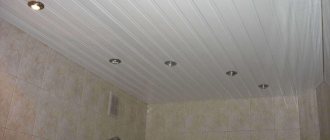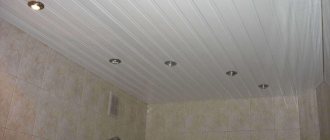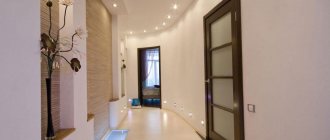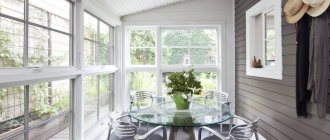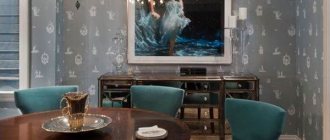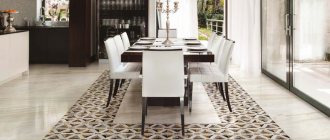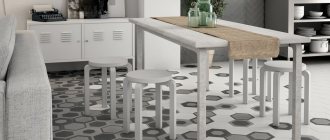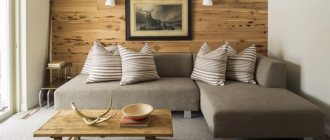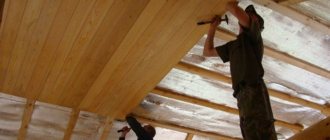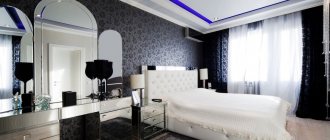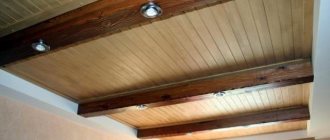The hallway in the house plays a huge role. It, like a business card, will tell visitors about the character of the owner of the house. First of all, guests enter the hallway and get their first impression of the interior of the entire house.
Therefore, when designing a hallway design, it is important to pay close attention to the little details, which should be practical and harmoniously combine all household items.
How to give the corridor a beautiful and sophisticated look? To find the answer to this question, you need to look up and look at the ceiling in the hallway.
Brief overview of the article
Basic recommendations for hallway design
Today there is a huge selection of products on the construction and finishing materials market. A person with any level of income will be able to choose the necessary fittings for the design of the ceiling in the hallway to suit their taste. Why do designers pay so much attention to it when planning a room? The issue is probably that:
- — visitors involuntarily glance upward when entering the room;
- - a clean ceiling in light colors gives the hallway a spacious look;
- — the use of certain technological solutions allows you to visually expand the space of the room;
- - a neat ceiling brings aesthetic satisfaction.
Having analyzed a huge number of photos of the ceiling in the hallway on specialized sites on the Internet, the observer will understand the difficulty of choosing a design solution.
Today, experts offer different finishing options. The ceiling can be whitewashed, painted with special paint, plastered, or ordered one of the decorative ceiling options.
- The option of whitewashing the ceiling in the hallway is the most popular. The material is inexpensive and is available at any building materials store. After whitewashing, the ceiling looks neat and visually increases the height of the room. The disadvantages of this design option include the fact that before work you need to perfectly level out all surface irregularities. Also, the whitewash needs to be updated at least once a year.
- Painting is also one of the most common options for finishing the ceiling in the hallway. To do this, you need to purchase ceiling paint in a specialized store. To give the surface the desired color scheme, tints are used (special dye for repair work). The painting option is also inexpensive.
- To plaster the ceiling, you need to purchase material from a hardware store. The interior design option is inexpensive, although more complex in execution. The essence of the method is simple: using decorative plaster and spatulas, a certain pattern is created on the ceiling. A huge advantage of the finishing method is that there is no need to smooth out all the flaws in the ceiling. The best option, of course, would be to invite professional plasterers who are highly qualified to work.
Ceiling color scheme
In addition to the material, when choosing a ceiling for a corridor, it is very important to take into account its color. It largely determines not only the aesthetic, but also the emotional component of the room’s design. After all, the fact that a person’s mood, his perception of the world around him, largely depends on the color scheme around him, has even been proven by science.
The choice of color for the ceiling in the corridor is made depending on its texture, as well as the color scheme used for the floor, walls and filling of the room.
White
A color that goes well with all others, highlighting their strengths. Makes adjacent colors brighter and more expressive. Significantly lightens the interior, gives it freshness and cleanliness. This classic option is universal: regardless of the style chosen in the room, it will always look great.
Black
The antipode of white, black also perfectly sets off the neighboring tones and combines with any interior. But it doesn’t add at all, and even hides space. And if there is too much of it, the room can take on a gloomy appearance. Therefore, it is very important to combine it correctly with other colors.
Turquoise
Entering the corridor, the ceiling of which is painted turquoise, a person gets the feeling of a “safe haven”. And this is not surprising, because marine shades soothe and relax. They cool the space and allow a person to balance.
Blue
But blue will create a completely different picture. It oppresses a person, squeezes the strength out of him and literally “squeezes” him out of the room. Moreover, the darker the shade, the stronger this effect. For lovers of this color, it is very important to combine it with lighter and lighter ones. For example, white.
Green
The color that is considered the most pleasing to the eye. It neither enlarges the room nor reduces it. Pairs perfectly with all shades of brown. With such a ceiling in the hallway, a person always feels comfortable in this room.
Brown
This color, like all its shades, creates a feeling of warmth and comfort in the corridor. Visually expands the room. It warms and soothes, giving a person a feeling of peace.
Red
Choosing red, on the contrary, will visually reduce the size of the room. Bright and unbridled, it speeds up the heartbeat and even causes some anxiety. In order not to provoke excessive aggressiveness, it is better to dilute this color with neutral tones: cream, sand, white.
Dark ceilings require much more intense lighting than light ones. You will have to clean dark ceiling structures much more often: dust is much more noticeable on them, so you will have to take care to always have a ladder at hand.
What you need to know about decorative ceilings?
The most practical solution when designing a ceiling in a hallway is to install artificial ceilings.
This design is more expensive than standard types of finishes. However, a huge number of advantages makes the consumer think about purchasing such material.
- Suspended ceilings in a small hallway give a mirror effect to the interior, giving an unusual look to the decoration.
- The design of a stretch ceiling in the hallway allows, in addition to the main task of decorating the room, to hide places that are “unnecessary” for prying eyes (hidden electrical wiring).
- This material is durable; you do not need to worry about updating the surface every year.
- Specialized companies offer a huge range of colors and design styles.
- When installing suspended ceilings, the kit usually comes with its own lighting fixtures. This gives a complete look to the hallway interior.
- Fast and high-quality installation by professional workers with preliminary surface measurement.
Forms and types
Ceiling coverings can be simple or suspended. In the first case, they are applied or attached directly to the base. In the second, they need to build a special frame. Simple ceilings are obtained by whitewashing or painting the surface, gluing wallpaper or polystyrene foam boards onto it. Their shape, in most cases, is a perfectly flat surface.
For suspended ceiling structures, transformations are limited only by the range of the designer's imagination. In addition, it is possible to construct both one-, two-, and multi-level systems.
Types of suspended ceilings:
- Plasterboard.
- Tension (mounted).
- Cassette.
- Rack and pinion.
- Hemmed.
The shape and type (or combination of several) ceiling structures are selected depending on individual taste preferences, budget for renovation, as well as architectural and other features of the room.
Plasterboard ceiling
Drywall has a smooth surface. Therefore, plasterboard ceilings in the hallway can be additionally covered with another material (paint, whitewash).
This option for interior decoration is inexpensive; installation can be done independently according to the instructions. A distinctive feature of drywall is its good moisture resistance.
Design options
Stretch ceilings differ not only in material, but also in the number of levels. The simplest and best option for hallways is a canvas stretched in one tier.
A more complex design - two levels. It is created in the following ways:
- A plasterboard box is erected (this is the lower tier), and a canvas (the upper tier) is stretched from it to the walls. Both fabric and film are used.
- They make a complex frame at different heights and stretch the canvas. With this method, only film is used, since it is more elastic.
The following designs are often found:
- one or more “tablets” - in the shape of a circle, flower, cloud, etc. (spotlights are often built into them);
- perimeter frame;
- division along or across the ceiling, straight or wavy;
- rings.
You don’t have to limit yourself to two levels; you can do three or more. But with each new tier the ceiling height will decrease (by 10-15 cm for the first and at least 3-5 for each next).
In a cramped hallway or narrow corridor, such designs will look out of place.
Plastic panels for ceiling finishing
The panels are made of plastic material in the form of rectangles. Manufacturers offer a wide range of color and style solutions. One of the advantages of the material is its low price and relative ease of installation.
With careful preparation for finishing the ceiling in the hallway, you can save a lot of money. The main rule for creating a harmonious interior is the correct choice of material, color design and high-quality work.
Lighting
When choosing one or another finishing option, you must immediately think through the lighting scheme.
As a rule, the hallway does not have natural light. Therefore, so that it does not look gloomy and dull, you will have to use a sufficient number of lighting fixtures.
Please note that for some types of materials there are certain restrictions. For example, it is unacceptable to use incandescent lamps and other heating lamps to illuminate a corridor with a suspended ceiling. Here you should use energy-saving LED bulbs with a power of no more than 35W. Light directed upward is also unacceptable, as it can cause overheating of the canvas.
Spotlights are often used. They hardly heat up, but require additional equipment with a transformer.
Proper lighting in the corridor.
No. 6. Mirror tiles
A mirrored ceiling is a bold and unconventional solution . On the one hand, a reflective surface is an opportunity to make a small hallway visually larger and taller , because even one light source will be reflected in the ceiling and illuminate the space well. On the other hand, you need to arrange everything so that the hallway does not turn into a laughing room.
Mirror plates may mean polystyrene plates coated with a mirror film: the reflection is blurry, but the material itself is cheap. Traditional mirror plates provide a clear image; they are heavier, more durable and of higher quality. This finishing material is secured with screws or special glue. You should be prepared in advance that you will need to take care of such a ceiling more often than any other finish.
